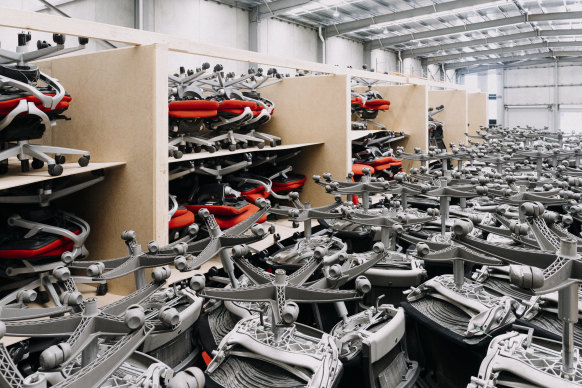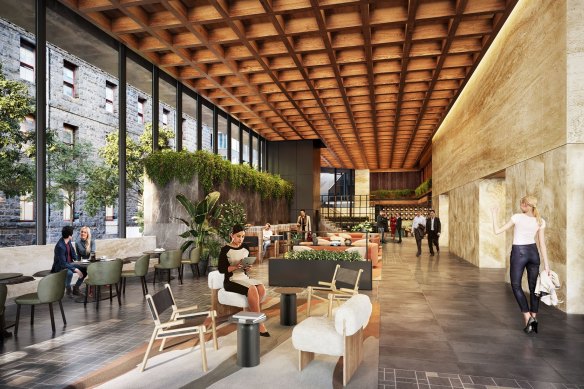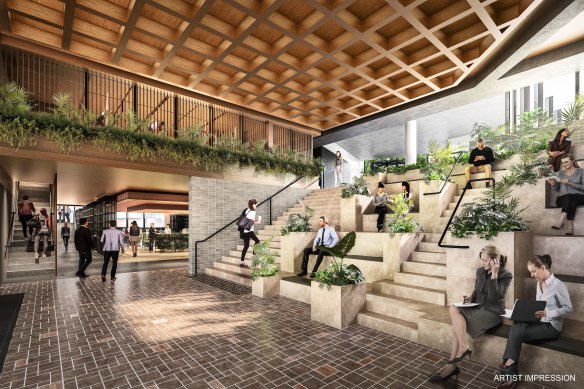Save articles for later
Add articles to your saved list and come back to them any time.
Key points
- The building at 500 Bourke street was built in 1977 and had the same tenant, NAB, for more than 40 years.
- Property giant has spent more than $160 million gutting and refurbishing the office building rather than knocking it down and rebuilding.
- Experts have said this should be happening more often in Melbourne with only around seven CBD commercial buildings retrofitted every year.
- The City of Melbourne estimated that in order to reach its carbon emissions targets that needs to increase to around 80 buildings per year.
An ageing Bourke Street skyscraper has had an expensive renovation – instead of being knocked down – in what experts say is a shining example of how buildings can be retrofitted.
Property giant ISPT has spent more than $160 million gutting and refurbishing NAB’s former headquarters at 500 Bourke Street, and months selling off and recycling the old office furniture, rather than sending it to landfill.
Rohan Fenton, manager of 500 Bourke Street, which has been retrofitted. Credit: Eddie Jim
Experts said this should be happening more often in Melbourne, with only around seven CBD commercial buildings retrofitted every year.
The City of Melbourne estimates that to reach its carbon emissions targets, that needs to increase to about 80 buildings per year.
The state government has also pushed for more retrofitting, with its landmark housing statement released in September calling for city office blocks to be converted into residential apartments.
Rohan Fenton, asset manager for 500 Bourke Street, said ISPT looked at all options for the building when NAB decided to vacate after more than 40 years as a tenant. The tower was built in 1977.
“The option first came up: do we knock the building over?” he said. “It’s a very large site footprint, nearly 4000 square metres, so theoretically, we could get about an 85,000-square-metre office tower on this site if we knocked it down.”
A knockdown and rebuild could have cost up to $500 million, but ISPT would have gained more lettable space.
ISPT also considered a “simple makeover” of the building by removing NAB’s fitout, repainting and updating the bathrooms, which it estimated would have cost $70 million, while conversion to residential apartments was dismissed because of what Fenton said were tough restrictions.
Instead, ISPT elected for what Fenton said is a “complete transformation”, turning the ageing building into an A-grade commercial property.
Old desk chairs from NAB that were diverted from landfill and sold or donated. Credit: ISPT
“It’s over 40 years old, but the tests of the engineers … show it’s going to last for another 40 or 50 years at least,” Fenton said. “Also, it’s an iconic building as well at 500 Bourke Street, not just a new glass box – it’s the Brutalist architecture, and it’s got character.”
Fenton said the building was well-constructed and so ISPT felt it could not justify its demolition. By refurbishing, it estimated a saving of approximately 57,000 tonnes of embodied carbon.
“The most sustainable building is one that’s already built, and not knocking down the building,” he said.
Gas was removed from the building, so it is entirely electrified and carbon-neutral, with all electricity coming from renewable sources.
ISPT also recycled or repurposed 85 per cent of NAB’s fitout, a process that Fenton said added another three months to the timeline and cost about $2 million.
“NAB’s ‘make good’ was they could walk out down the street and walk into their own building,” Fenton said. “They left over 15,000 pieces of office equipment: all the old [ceiling] tiles, all the chairs, all the carpet, all the desks, filing cabinets, all left. It would have been a lot easier for us to get the demo [demolition] company to come in and chuck it to landfill.”
A lot of the old furniture was donated or sold off, with ISPT raising $200,000 for charity in the process.
The retrofit was further delayed by the COVID pandemic, a discovery of asbestos in the building and the collapse of builder Probuild and four subcontractors. But despite the delays, Fenton said the first tenants are set to move into the building mid-December.
An artist’s impression of the retrofitted tower at 500 Bourke Street.
The building is already 60 per cent leased, while 20 per cent of the remaining area is under offer, which Fenton attributes to its environmental credentials.
“We are definitely in the top three most-leased buildings in Melbourne, probably behind 555 Collins Street and 101 Collins Street,” Fenton said.
Sarah Bell, University of Melbourne chair in urban resilience and innovation, said more developers and builders needed to retrofit buildings to address the energy used to construct buildings, known as embodied carbon, and the resources wasted in demolition.
“There are some high-end clients in the CBD who are now recognising embodied carbon as an issue,” she said.
An artist impression’s of the new foyer at 500 Bourke Street, which is already 60 per cent leased.
“Those kinds of embodied carbon arguments help to pitch a building to the market as the next frontier in the most efficient environmental building that you can own, lease, or work in.”
Bell said the planning system and government was still lagging behind the market.
“Government could really lead the market in this by saying, ‘we’re going to retrofit all of our own properties’, and that could be schools, it could be hospitals, it could be their offices in Melbourne’s CBD,” she said.
“If they want to make a public or infrastructure investment announcement, that still is ‘let’s build a new road’ or ‘let’s build a new railway’.”
Get the day’s breaking news, entertainment ideas and a long read to enjoy. Sign up to receive our Evening Edition newsletter.
Most Viewed in National
From our partners
Source: Read Full Article






